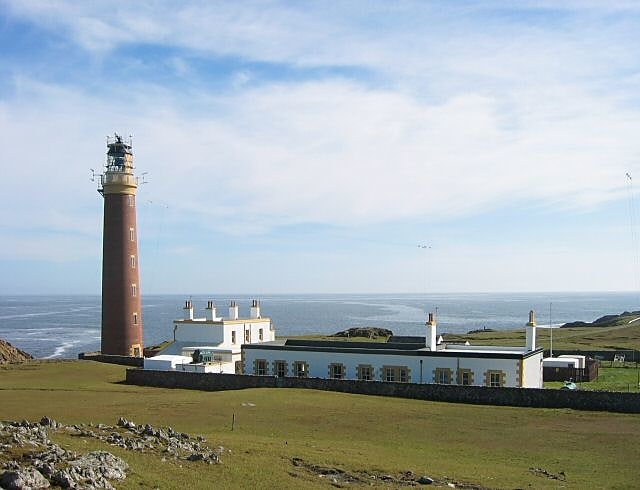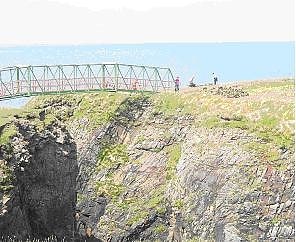Discover 4 hidden attractions, cool sights, and unusual things to do in Port of Ness (United Kingdom). Don't miss out on these must-see attractions: Butt of Lewis Lighthouse, Teampall Mholuaidh, and Dùn Èistean. Also, be sure to include Port Stoth in your itinerary.
Below, you can find the list of the most amazing places you should visit in Port of Ness (Scotland).
Table of Contents
Butt of Lewis Lighthouse

Lighthouse in Scotland. Butt of Lewis Lighthouse, designed by David Stevenson, was built at Butt of Lewis to aid shipping in the 1860s. Unusual for a lighthouse in Scotland, it is constructed of red brick, and is unpainted. The station was automated in 1998, one of the last to be converted. A modern differential GPS base station has now been sited on a nearby hill to further aid navigation. This hill was also the site for a Lloyd's Signal Station from the 1890s.
The road to the lighthouse passes a sheltered cove called Port Stoth. Agricultural lazy beds are also visible along the coast. The Butt of Lewis features some of the oldest rocks in Europe, having been formed in the Precambrian period up to 3000 million years ago. Following the coast southwest from the lighthouse there is a natural arch called the "Eye of the Butt" (Scottish Gaelic: Toll a’ Ròigh). It can be best viewed from the Habost machair.[1]
Teampall Mholuaidh

Church in Scotland. St Moluag's church is a church in the village of Eoropie in Ness in the Isle of Lewis in Scotland. It is one of the busiest visitor attractions in Ness, due to historical importance and because it is easily accessible from the road along a footpath.
Various sources attribute its construction to between the 12th and 16th centuries and small scale excavations in the 1970s did not provided any evidence on its date. The church has a basic T-shaped structure, with two small chapels on either side of the main body of the church. The southern chapel can only be accessed from outside. Outside is a war memorial in the form of a Celtic cross.
The church was restored in 1911-12 and were supervised by James S. Richardson. The pulpit, altar and font are 1911.
The church is now in use as a Scottish Episcopal Church. Regular services were revived in 1994. A lack of heating and lighting means during the winter when alternative premises in Tong are used.
The church is traditionally considered to be the MacLeods’ church.[2]
Dùn Èistean

Building in Scotland. Dùn Èistean is a multi-period archaeological site on an inter-tidal sea stack on the north east coast of the Isle of Lewis, near the village of Knockaird in the area of Nis in the Western Isles of Scotland. It is accorded the status of traditional stronghold of Clan Morrison, once a highly powerful family within the Lordship of the Isles, in local oral tradition. The ruins of two large buildings and groups of interconnecting cellular structures can be seen amongst the grassy tussocks on the top of the island, as well as an artificial pond and a low turf wall enclosing the site. The most prominent feature of the site is a large circular mound of rubble situated on the highest point of the stack, on the north east side of the site. The topographical survey of the site shows these buildings.
The island would have provided all that was needed for occupation, having its own fresh water supply in the form of the artificial pond, and numerous buildings serving an array of purposes, from storage to sleeping quarters.[3]
Port Stoth

Port Stoth, known locally as Stoth and pronounced Stow, is a sheltered inlet just southeast of the Butt of Lewis in the Outer Hebrides, Scotland. It is the most northerly landing in the Outer Hebrides. A track leads down to a slipway which runs across the sandy beach.
Port Stoth is about 400 yards (370 m) from the Butt of Lewis Lighthouse. All the materials for the construction of the lighthouse (between 1859 and 1862) were brought by ship and landed in Port Stoth, due to lack of road infrastructure. The port continued to play an important role in bringing supplies to the lighthouse until about 1960. Supplies and fuel were brought in small cargo vessels when the weather allowed, and were unloaded in Port Stoth by crane. The concrete base still remains, as does a brick storage building.
There is a brick building to the North side of Stoth where shellfish was landed and there are the remains of a hoist fixed to the shore below.[4]